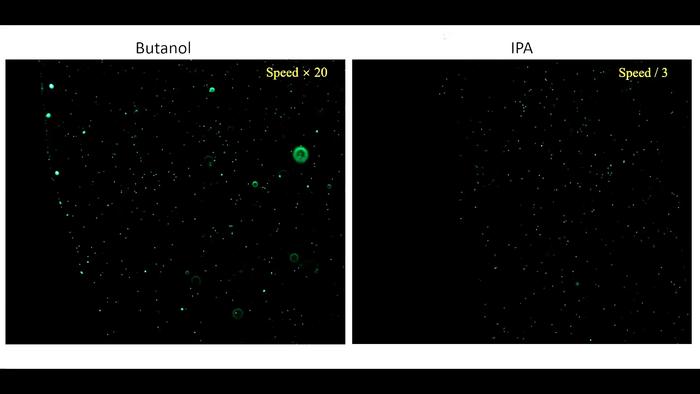Fukuoka, Japan—From the rain drops rolling down your window, to the fluid running across a COVID rapid test, we cannot go a day without observing the world of fluid dynamics. Naturally, how liquids traverse across, and through, surfaces are a heavily researched subject, where new discoveries can have profound effects in the fields of energy conversion technology, electronics cooling, biosensors, and micro-/nano-fabrications.

Credit: Kyushu University/Inoue Lab
Fukuoka, Japan—From the rain drops rolling down your window, to the fluid running across a COVID rapid test, we cannot go a day without observing the world of fluid dynamics. Naturally, how liquids traverse across, and through, surfaces are a heavily researched subject, where new discoveries can have profound effects in the fields of energy conversion technology, electronics cooling, biosensors, and micro-/nano-fabrications.
Now, using mathematical modeling and experimentation, researchers from Kyushu University’s Faculty of Engineering have expanded on a fundamental principle in fluid dynamics. Their new findings may lead to more efficient product development in many liquid-based industries such as high-end electronics manufacturing and lab-on-a-chip disease diagnosis.
“We are living in an ever-present world of liquid and flow,” explains Assistant Professor Zhenying Wang, the first author of the study that was published in the Journal of Fluid Dynamics. “Over the decades, scientist have made efforts to mathematically describe the seemingly simple phenomena of liquid flow and spreading. For example, Tanner’s law describes how a droplet of water spreads on a solid surface over time.”
However, these equations remain incomplete. Even the classic Tanner’s law is only valid for non-volatile liquids like oil. The law becomes less reliable when it comes to volatile liquids like water, alcohol, and perfumes due to the thermodynamics between the air, liquid, and surface coming into play.
“Therefore, we looked into the current laws in hopes of expanding our understanding of the dynamics of volatile liquids,” continues Wang. “We began by mathematically introducing parameters that reflect how volatile liquids react under similar conditions when Tanner’s law was derived.”
The team—in collaboration with Prashant Valluri of the University of Edinburgh and George Karapetsas of Aristotle University of Thessaloniki—then conducted a series of experiments carefully imaging the movement and thermodynamics of volatile liquids. These two approaches allowed the researchers scale up the established fluid dynamic principles and put together a more diverse picture of the physics of volatile liquids interacting with a surface and the air.
“The work here depicts a vast range of real cases and draws a more complete picture of liquid dynamics that could not be explained simply by Tanner’s law,” explains co-author of the paper Associate Professor Chihiro Inoue. “At a more practical level, these results could play a significant role in various liquid-based industries, for example in the cooling of electronics and other energy devices. The world of fluid dynamics can be very meticulous, but careful examination of it is required if we hope to decipher the fundamental flows around us.”
###
For more information about this research, see “Role of Volatility and Thermal Properties in Droplet Spreading: A Generalization to Tanner’s Law,” Zhenying Wang, George Karapetsas, Prashant Valluri, and Chihiro Inoue Journal of Fluid Mechanics, https://doi.org/10.1017/jfm.2024.385
About Kyushu University
Founded in 1911, Kyushu University is one of Japan’s leading research-oriented institutes of higher education, consistently ranking as one of the top ten Japanese universities in the Times Higher Education World University Rankings and the QS World Rankings. The university is one of the seven national universities in Japan, located in Fukuoka, on the island of Kyushu—the most southwestern of Japan’s four main islands with a population and land size slightly larger than Belgium. Kyushu U’s multiple campuses—home to around 19,000 students and 8000 faculty and staff—are located around Fukuoka City, a coastal metropolis that is frequently ranked among the world’s most livable cities and historically known as Japan’s gateway to Asia. Through its VISION 2030, Kyushu U will “drive social change with integrative knowledge.” By fusing the spectrum of knowledge, from the humanities and arts to engineering and medical sciences, Kyushu U will strengthen its research in the key areas of decarbonization, medicine and health, and environment and food, to tackle society’s most pressing issues.
Journal
Journal of Fluid Mechanics
DOI
10.1017/jfm.2024.385
Method of Research
Experimental study
Subject of Research
Not applicable
Article Title
Role of Volatility and Thermal Properties in Droplet Spreading: A Generalization to Tanner’s Law
Article Publication Date
17-May-2024
COI Statement
The authors report no conflict of interest




